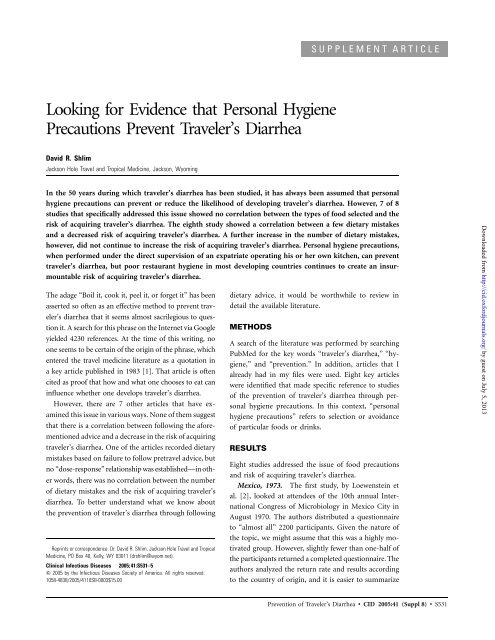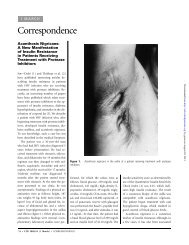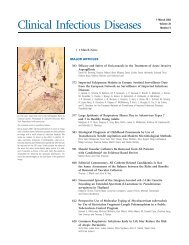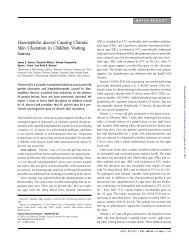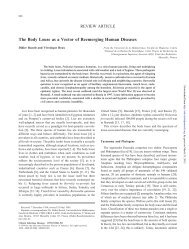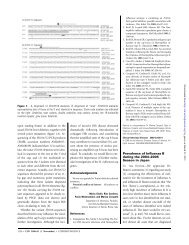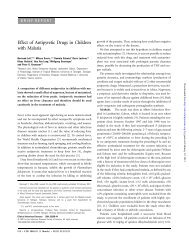Looking for Evidence that Personal Hygiene Precautions Prevent ...
Looking for Evidence that Personal Hygiene Precautions Prevent ...
Looking for Evidence that Personal Hygiene Precautions Prevent ...
You also want an ePaper? Increase the reach of your titles
YUMPU automatically turns print PDFs into web optimized ePapers that Google loves.
<strong>Looking</strong> <strong>for</strong> <strong>Evidence</strong> <strong>that</strong> <strong>Personal</strong> <strong>Hygiene</strong><br />
<strong>Precautions</strong> <strong>Prevent</strong> Traveler’s Diarrhea<br />
David R. Shlim<br />
Jackson Hole Travel and Tropical Medicine, Jackson, Wyoming<br />
SUPPLEMENT ARTICLE<br />
In the 50 years during which traveler’s diarrhea has been studied, it has always been assumed <strong>that</strong> personal<br />
hygiene precautions can prevent or reduce the likelihood of developing traveler’s diarrhea. However, 7 of 8<br />
studies <strong>that</strong> specifically addressed this issue showed no correlation between the types of food selected and the<br />
risk of acquiring traveler’s diarrhea. The eighth study showed a correlation between a few dietary mistakes<br />
and a decreased risk of acquiring traveler’s diarrhea. A further increase in the number of dietary mistakes,<br />
however, did not continue to increase the risk of acquiring traveler’s diarrhea. <strong>Personal</strong> hygiene precautions,<br />
when per<strong>for</strong>med under the direct supervision of an expatriate operating his or her own kitchen, can prevent<br />
traveler’s diarrhea, but poor restaurant hygiene in most developing countries continues to create an insurmountable<br />
risk of acquiring traveler’s diarrhea.<br />
The adage “Boil it, cook it, peel it, or <strong>for</strong>get it” has been<br />
asserted so often as an effective method to prevent traveler’s<br />
diarrhea <strong>that</strong> it seems almost sacrilegious to question<br />
it. A search <strong>for</strong> this phrase on the Internet via Google<br />
yielded 4230 references. At the time of this writing, no<br />
one seems to be certain of the origin of the phrase, which<br />
entered the travel medicine literature as a quotation in<br />
a key article published in 1983 [1]. That article is often<br />
cited as proof <strong>that</strong> how and what one chooses to eat can<br />
influence whether one develops traveler’s diarrhea.<br />
However, there are 7 other articles <strong>that</strong> have examined<br />
this issue in various ways. None of them suggest<br />
<strong>that</strong> there is a correlation between following the a<strong>for</strong>ementioned<br />
advice and a decrease in the risk of acquiring<br />
traveler’s diarrhea. One of the articles recorded dietary<br />
mistakes based on failure to follow pretravel advice, but<br />
no “dose-response” relationship was established—in other<br />
words, there was no correlation between the number<br />
of dietary mistakes and the risk of acquiring traveler’s<br />
diarrhea. To better understand what we know about<br />
the prevention of traveler’s diarrhea through following<br />
Reprints or correspondence: Dr. David R. Shlim, Jackson Hole Travel and Tropical<br />
Medicine, PO Box 40, Kelly, WY 83011 (drshlim@wyom.net).<br />
Clinical Infectious Diseases 2005; 41:S531–5<br />
2005 by the Infectious Diseases Society of America. All rights reserved.<br />
1058-4838/2005/4110S8-0003$15.00<br />
dietary advice, it would be worthwhile to review in<br />
detail the available literature.<br />
METHODS<br />
A search of the literature was per<strong>for</strong>med by searching<br />
PubMed <strong>for</strong> the key words “traveler’s diarrhea,” “hygiene,”<br />
and “prevention.” In addition, articles <strong>that</strong> I<br />
already had in my files were used. Eight key articles<br />
were identified <strong>that</strong> made specific reference to studies<br />
of the prevention of traveler’s diarrhea through personal<br />
hygiene precautions. In this context, “personal<br />
hygiene precautions” refers to selection or avoidance<br />
of particular foods or drinks.<br />
RESULTS<br />
Eight studies addressed the issue of food precautions<br />
and risk of acquiring traveler’s diarrhea.<br />
Mexico, 1973. The first study, by Loewenstein et<br />
al. [2], looked at attendees of the 10th annual International<br />
Congress of Microbiology in Mexico City in<br />
August 1970. The authors distributed a questionnaire<br />
to “almost all” 2200 participants. Given the nature of<br />
the topic, we might assume <strong>that</strong> this was a highly motivated<br />
group. However, slightly fewer than one-half of<br />
the participants returned a completed questionnaire. The<br />
authors analyzed the return rate and results according<br />
to the country of origin, and it is easier to summarize<br />
<strong>Prevent</strong>ion of Traveler’s Diarrhea • CID 2005:41 (Suppl 8) • S531<br />
Downloaded from<br />
http://cid.ox<strong>for</strong>djournals.org/ by guest on July 5, 2013
their results if we limit our focus to the group of participants<br />
from the United States and Canada. Of this group, 597 (58%)<br />
of 1029 attendees returned questionnaires. Of these 597 persons,<br />
325 (54%) reported at least 1 episode of traveler’s diarrhea.<br />
The questionnaire specifically asked whether the person<br />
drank bottled liquids or avoided salads, raw vegetables, and<br />
unpeeled fruit. The attack rate of traveler’s diarrhea among<br />
persons who said <strong>that</strong> they took these precautions was the same<br />
as <strong>that</strong> among those who said <strong>that</strong> they did not take these<br />
precautions. The conclusion of these authors was <strong>that</strong> “drinking<br />
bottled liquids, and avoiding salads, raw vegetables, and unpeeled<br />
fruits also failed to prevent illness” [2, page 530].<br />
Mexico, 1976. The second study, by Merson et al. [3], was<br />
also per<strong>for</strong>med at a medical conference in Mexico. The subjects<br />
included 73 physicians and 48 of their family members who<br />
were attending the Fifth World Congress of Gastroenterology<br />
in Mexico City in October 1974. Traveler’s diarrhea occurred<br />
in 59 persons (49%). This highly motivated group of participants<br />
provided stool specimens be<strong>for</strong>e, during, and after their<br />
1–2-week trip to Mexico. In addition, the 73 physicians provided<br />
a serum sample be<strong>for</strong>e and after the trip.<br />
A questionnaire was given to all participants 10 days after<br />
they left Mexico. The questionnaire contained questions regarding<br />
the consumption of food and water while in Mexico.<br />
All participants completed the questionnaire. The authors concluded<br />
<strong>that</strong> “illness was not associated with consumption of<br />
water or iced beverages.…Illness was similarly not associated<br />
with consumption of vendor food, salads containing raw vegetables,<br />
other raw vegetables, or unpeeled fruits” [3, page 1303].<br />
However, the subgroup of participants who acquired infections<br />
with enterotoxigenic Escherichia coli had eaten salads containing<br />
raw vegetables significantly more often than had noninfected<br />
participants ( ). This increased risk was not associated<br />
P p .014<br />
with consumption of other raw vegetables or unpeeled fruits.<br />
Mexico and Peru, 1978. Chang distributed questionnaires<br />
to charter passengers returning from Mexico ( ) and<br />
n p 162<br />
Peru ( ) [4]. The questionnaires inquired about the sen<br />
p 65<br />
verity and number of episodes of traveler’s diarrhea and the<br />
risk factors <strong>for</strong> acquiring traveler’s diarrhea. Eighty-two percent<br />
of the travelers to Mexico experienced traveler’s diarrhea,<br />
whereas 60% of the travelers to Peru reported traveler’s diarrhea.<br />
The author noted, “Avoidance of tap water, uncooked<br />
foods, and ice cubes did not make a difference in the outcome”<br />
[4, page 429]. No details about individual risk factors are given.<br />
Worldwide, 1983. Steffen et al. [5] surveyed nearly 10,000<br />
tourists about their food precautions and risk of acquiring traveler’s<br />
diarrhea in various destinations worldwide. For a 22month<br />
period, a questionnaire was handed out by air crew<br />
members on flights returning to Switzerland and Germany from<br />
numerous international destinations. A total of 16,568 questionnaires<br />
were distributed, and 60.2% were completed and<br />
S532 • CID 2005:41 (Suppl 8) • Shlim<br />
returned. The rates of traveler’s diarrhea in developing countries<br />
were 30%–57%. Steffen et al. [5] used a unique method<br />
of evaluating the rate of traveler’s diarrhea among tourists who<br />
applied different levels of food precautions. The baseline rate<br />
of diarrhea in all travelers (33.9%) was given the value of 1.0.<br />
The results are shown in table 1. The table demonstrates <strong>that</strong>,<br />
in a retrospective study of traveler’s diarrhea, subjects who<br />
appeared to exercise more caution were at increased risk of<br />
acquiring traveler’s diarrhea. Or, as the authors stated: “Thus,<br />
diarrhea seemed to occur more frequently the more a person<br />
tried to elude it!” [5, page 1179], Even if we ignore, <strong>for</strong> the<br />
moment, the inverse relationship between dietary precautions<br />
and the recall of having experienced traveler’s diarrhea, the<br />
study certainly did not provide evidence <strong>that</strong> tourists who were<br />
more cautious about what they chose to eat were protected<br />
against traveler’s diarrhea.<br />
Steffen et al. [5] also noted a differential risk between resort<br />
hotels, even at the same general destination. A 2-month survey<br />
of 21 hotels in Tunisia, with a minimum of 20 tourists at each<br />
hotel during <strong>that</strong> period, revealed an incidence of traveler’s diarrhea<br />
<strong>that</strong> varied from 26% to 89%. Thus, the source of food<br />
(i.e., the individual hotels), not the choice of foods, appeared to<br />
make a large difference in the risk of acquiring traveler’s diarrhea.<br />
Worldwide (children), 1991. Data on the risk of acquiring<br />
traveler’s diarrhea in traveling children are scarce. Pitzinger et<br />
al. [6] per<strong>for</strong>med the one study <strong>that</strong> focused on the risk and<br />
severity of traveler’s diarrhea in a retrospective study of traveling<br />
Swiss families. Families <strong>that</strong> had sought pretravel advice<br />
and <strong>that</strong> had children between the ages of 0 and 20 years were<br />
sent questionnaires within 2 weeks of their return from a trip<br />
to the tropics or subtropics. Questionnaires were sent to households<br />
of 446 young travelers, and 363 (81.4%) of the questionnaires<br />
were returned and evaluated. The population of children<br />
was stratified according to age, as follows: 0–2 years (n<br />
p 20); 3–6 years ( n p 47); 7–14 years ( n p 46);<br />
and 15–20<br />
years ( n p 250).<br />
Surprisingly, 60.1% of the respondents (n p<br />
218) stated <strong>that</strong> they took no personal hygiene precautions.<br />
Thirty-eight percent of the travelers stated <strong>that</strong> they regularly<br />
employed preventive measures with regard to eating. Parents<br />
Table 1. Food precautions taken by travelers versus the risk<br />
of acquiring traveler’s diarrhea, compared with the average risk<br />
of acquiring traveler’s diarrhea.<br />
Food precaution<br />
No. of<br />
travelers<br />
Risk<br />
value P<br />
No precautions 3382 0.88 !.001<br />
Avoided tap water only 1518 0.97 NS<br />
Followed 1 recommended precaution 2530 1.08 !.01<br />
Any no. and type of precaution 5966 1.09 !.001<br />
Took 3 precautions 1041 1.13 !.001<br />
NOTE. The risk of acquiring traveler’s diarrhea appears to increase with<br />
increasing adherence to food precautions. Adapted from Steffen et al. [5]. NS,<br />
not significant.<br />
Downloaded from<br />
http://cid.ox<strong>for</strong>djournals.org/ by guest on July 5, 2013
tended to be more cautious with their children who were !3<br />
years old: the parents of 12 (60%) of the 20 children in this<br />
age group said <strong>that</strong> they had consistently followed dietary<br />
guidelines. This percentage decreased to 34%–48% <strong>for</strong> parents<br />
of children in the other age groups.<br />
The incidence of traveler’s diarrhea in the 0–2-year age group<br />
was 60%, despite the added care <strong>that</strong> their parents exercised.<br />
The rate of traveler’s diarrhea in this age group, expressed as<br />
the risk of acquiring traveler’s diarrhea per 14 days, was 40%.<br />
The rate of traveler’s diarrhea per 14 days in the other age<br />
groups was as follows: 3–6 years, 8.5%; 7–14 years, 21.7%; and<br />
15–20 years, 36.0%.<br />
The authors looked <strong>for</strong> correlations between the families <strong>that</strong><br />
followed eating precautions and the rate of traveler’s diarrhea.<br />
They concluded <strong>that</strong> “no significant differences between those<br />
who did and did not adhere to the rules were observed in children<br />
below the age of 15 years” [6, page 1991]. In the 15–20year<br />
age group, the protective effect of eating precautions just<br />
reached significance ( ).<br />
P ! .05<br />
Again, <strong>for</strong> reasons <strong>that</strong> are difficult to explain, young children<br />
whose parents took the most precautions had the highest rate<br />
of traveler’s diarrhea. This finding may be related to the increased<br />
susceptibility to pathogens among children in the 0–<br />
2-year age group, but, even if this is true, trying to prevent<br />
ingestion of pathogens should decrease the rate of illness.<br />
Morocco, 1995. When hygienic eating precautions are evaluated,<br />
the question is always raised as to whether these rules are<br />
capable of being applied while traveling or whether travelers are<br />
motivated to do so. Certainly, the rate of dietary mistakes is high<br />
where it has been evaluated. If the risk of acquiring traveler’s<br />
diarrhea is associated with eating or avoiding certain foods or<br />
types of foods, travelers who adhere to this advice the most closely<br />
should be least likely to experience traveler’s diarrhea. However,<br />
this was not the case in the study conducted by Matilla et al. [7]<br />
among Finnish travelers to Morocco. The subjects were tourists<br />
on package tours to Morocco <strong>for</strong> 1 or 2 weeks. Subjects were<br />
contacted by letter prior to travel, and those willing to participate<br />
in the study were seen by an investigator and given a questionnaire<br />
to be filled out during the trip. The questionnaire contained<br />
questions about the consumption of 13 different food and beverage<br />
items. A total of 993 persons completed the study and<br />
supplied a stool sample. However, the majority of the study<br />
population ( ) was randomized to receive the B subunit–<br />
n p 788<br />
whole-cell cholera vaccine, which offers some protection against<br />
enterotoxigenic E. coli, or placebo. Of the group who received<br />
only placebo or no vaccine ( ), 155 (28%) developed<br />
n p 547<br />
traveler’s diarrhea during their trip.<br />
The authors observed <strong>that</strong> only 46 (5%) of the total number<br />
of travelers claimed to have made no dietary mistakes. Of<br />
this group, 15 (33%) developed traveler’s diarrhea. The authors<br />
stated: “the incidence of traveler’s diarrhea was not associated<br />
with the presence or absence of any specific dietary errors or<br />
the number of them committed” [7, page 81].<br />
Nepal, 1996. After living in Nepal and running the main<br />
travel medicine clinic <strong>that</strong> took care of <strong>for</strong>eigners there <strong>for</strong> 12<br />
years, I realized <strong>that</strong> we still did not have solidly based recommendations<br />
<strong>that</strong> could help a traveler prevent traveler’s diarrhea.<br />
We undertook a year-long study in 1992–1993 to evaluate<br />
risk factors <strong>for</strong> traveler’s diarrhea, focusing in particular<br />
on the expatriate (<strong>for</strong>eign resident) population who lived at<br />
continuous risk of acquiring traveler’s diarrhea [8]. Sixty-nine<br />
expatriates and 120 tourists with traveler’s diarrhea were enrolled<br />
in the study and were compared with 112 asymptomatic<br />
tourist and expatriate control subjects. The people with diarrhea<br />
were randomly enrolled each day if they happened to be the<br />
first 2 patients of the day with stool soft enough to con<strong>for</strong>m<br />
to the cup used <strong>for</strong> stool collection. They were then asked to<br />
complete a 10-page questionnaire. The control subjects were<br />
recruited from patients at the Canadian International Water<br />
and Energy Consultants Clinic (Kathmandu, Nepal) who presented<br />
with a nongastrointestinal complaint, had not experienced<br />
diarrhea <strong>for</strong> at least 2 weeks, and were willing to supply<br />
a stool sample and fill out the same questionnaire.<br />
The results of our case-control study of risk factors are summarized<br />
in table 2. The traditionally mentioned risk factors—<br />
ingestion of tap water, ice, unpeeled fresh fruit, or raw vegetables—were<br />
not associated with an increased risk of acquiring<br />
traveler’s diarrhea. However, the case-control method did detect<br />
a risk from simply eating in a restaurant and from eating<br />
other foods not previously thought to be associated with an<br />
increased risk of acquiring traveler’s diarrhea. Eating foods <strong>that</strong><br />
are cooked earlier in the day and then are allowed to sit at<br />
room temperature <strong>for</strong> a prolonged period be<strong>for</strong>e serving (e.g.,<br />
quiche, lasagna, or casseroles) was highly associated with traveler’s<br />
diarrhea. In addition, drinking a blended fruit and yogurt<br />
drink, called a “lassi” in Nepal, was also highly associated with<br />
traveler’s diarrhea. These positive associations confirmed the<br />
value of the case-control method in determining risk factors.<br />
We concluded: “Our study failed to confirm as risk factors<br />
among residents certain foods widely believed to be associated<br />
with traveler’s diarrhea, such as leafy vegetables, unpeeled fruits,<br />
untreated water, and ice” [8, page 536–7].<br />
Worldwide, 1985. Kozicki et al. [1] attempted to try to<br />
overcome some of the limitations of memory recall associated<br />
with questionnaires <strong>that</strong> are given to travelers after they return<br />
from a trip and have (or have not) already experienced traveler’s<br />
diarrhea. They distributed 2240 questionnaires to Swiss travelers<br />
departing to a wide variety of destinations. The travelers<br />
were asked to record their eating choices <strong>for</strong> the first 3 days<br />
of their holiday and to note whether they experienced traveler’s<br />
diarrhea during the first 5 days of their trip. They were then<br />
to return the questionnaire at the end of the trip.<br />
Six hundred eighty-eight (30.7%) of the 2240 travelers who<br />
<strong>Prevent</strong>ion of Traveler’s Diarrhea • CID 2005:41 (Suppl 8) • S533<br />
Downloaded from<br />
http://cid.ox<strong>for</strong>djournals.org/ by guest on July 5, 2013
Table 2. Risk factors <strong>for</strong> traveler’s diarrhea among <strong>for</strong>eign residents of Nepal.<br />
Risk factor<br />
S534 • CID 2005:41 (Suppl 8) • Shlim<br />
Case patients<br />
(n p 69)<br />
Control subjects<br />
(n p 87) P<br />
Drank untreated water 6 (9) 8 (9) NS<br />
Took ice in drink 6/67 a (9) 10 (11) NS<br />
Ate raw vegetables 26/68 a (38) 29 (33) NS<br />
Ate unpeeled fresh fruit 27 (39) 32 (37) NS<br />
Ate fruit salad in restaurant 23/68 a (34) 28 (32) NS<br />
Ate at least 1 meal in restaurant during preceding week 66 (96) 72 (83) .01<br />
Meals eaten in restaurant during preceding week, median no. (IQR) 4 (2–7) 2 (1–5) .03<br />
Ate foods <strong>that</strong> require reheating b<br />
15 (22) 6 (7) .007<br />
Drank lassi c<br />
22/68 a (32) 8/86 a (9) !.001<br />
NOTE. Data are no. (%) of patients or subjects, except where noted. Adapted from Hoge and Shlim [8]. IQR, interquartile<br />
range; NS, not significant.<br />
a Denominator used in the calculation of the percentage excludes persons who did not answer the question regarding this risk<br />
factor.<br />
b For example, quiche, lasagna, or casseroles.<br />
c A blended fruit/yogurt drink.<br />
accepted questionnaires actually returned a completed questionnaire.<br />
As the authors concede, this subgroup of travelers<br />
may not be representative of the entire group. We do not know<br />
what happened to the other 1552 people. The self-selection of<br />
travelers who decided to record their eating choices may not<br />
be representative of the group as a whole. However, the study<br />
is the only prospective study of eating choices in relation to<br />
traveler’s diarrhea <strong>that</strong> has been attempted, so the authors decided<br />
to report the results anyway.<br />
Only 13 travelers (2%) were able to adhere to the dietary<br />
precautions they had been given. In the group <strong>that</strong> made 0–1<br />
dietary mistakes ( ), there were 3 cases of traveler’s din<br />
p 51<br />
arrhea. The rate of traveler’s diarrhea increased to 24% in the<br />
group <strong>that</strong> made 6–7 mistakes, and it then leveled off, despite<br />
an increase in total mistakes (<strong>for</strong> a total of 13). In other words,<br />
a further number of dietary mistakes did not continue to increase<br />
the risk of acquiring traveler’s diarrhea beyond the risk<br />
<strong>that</strong> existed in association with 7 mistakes, the point at which<br />
24% of tourists got traveler’s diarrhea.<br />
In addition to the number of dietary mistakes made, the<br />
study looked at particular risk factors. Drinking bottled water<br />
was a significant risk <strong>for</strong> traveler’s diarrhea, although drinking<br />
tap water was not. Use of ice cubes appeared to be a significant<br />
risk. Drinking fruit juice, whether bottled or not, was not associated<br />
with traveler’s diarrhea, neither was eating peeled or<br />
unpeeled tomatoes. Eating peeled or unpeeled fruits was not<br />
associated with traveler’s diarrhea. However, eating raw salads<br />
was associated with traveler’s diarrhea in this study. In addition,<br />
consumption of cold meats or raw meat (steak tartare) was<br />
associated with traveler’s diarrhea, as was consumption of raw<br />
oysters. If you look at the list of significant and nonsignificant<br />
risk factors, there is no clear pattern <strong>that</strong> supports the adage<br />
“Boil it, cook it, peel it, or <strong>for</strong>get it.”<br />
DISCUSSION<br />
Seven studies of risk factors <strong>for</strong> traveler’s diarrhea, conducted<br />
during a 23-year period, failed to find any correlation between<br />
following the usual dietary precautions and a diminished risk<br />
of acquiring traveler’s diarrhea. The eighth study appeared to<br />
show a correlation between cumulative dietary mistakes and<br />
an increased risk of acquiring traveler’s diarrhea over a 3-day<br />
period, but a review of the individual foods associated with<br />
traveler’s diarrhea—<strong>for</strong> example, showing <strong>that</strong> drinking bottled<br />
water was associated with traveler’s diarrhea whereas drinking<br />
tap water was not—makes it difficult to understand the risks<br />
associated with consumption of individual foods.<br />
In an editorial accompanying the publication of the article by<br />
Steffen et al. in 1983 [5], DuPont et al. concluded: “While food<br />
is the major vehicle of transmission, Steffen et al. provide data<br />
<strong>that</strong> indicate we cannot avoid the problem [of traveler’s diarrhea]<br />
by exercising care in where and what we eat” [9, page 1194]. In<br />
a review of the papers available to him in 1986, Blaser wrote:<br />
“Surprisingly, the drinking of bottled liquids and the avoidance<br />
of salads, raw vegetables, and unpeeled fruit failed to prevent<br />
diarrhea…These results may suggest <strong>that</strong> the etiologic agents<br />
which cause travelers’ diarrhea are so ubiquitous in high-risk<br />
areas <strong>that</strong> preventive measures are without value” [10, page S144].<br />
Despite the evidence and the opinions of experts, the belief<br />
<strong>that</strong> food precautions could reduce the likelihood of traveler’s<br />
diarrhea continued to be asserted. A consensus panel on traveler’s<br />
diarrhea convened by the National Institutes of Health<br />
in 1985 concluded <strong>that</strong> “data indicate <strong>that</strong> meticulous attention<br />
to food and beverage preparation can decrease the likelihood<br />
of developing traveler’s diarrhea” [11, page 2702]. At <strong>that</strong> point<br />
in time, the only “data” <strong>that</strong> they could be referring to is the<br />
article by Kozicki et al. [1]. They appear to ignore the 3 earlier<br />
articles <strong>that</strong> failed to find such a correlation. However, the<br />
Downloaded from<br />
http://cid.ox<strong>for</strong>djournals.org/ by guest on July 5, 2013
consensus statement went on to say, “Most travelers encounter<br />
great difficulty in observing the requisite dietary restrictions”<br />
[11, page 2702]. In other words, the advice must be correct,<br />
but travelers simply cannot follow it.<br />
Where does this leave the traveler and the travel health professional?<br />
It appears <strong>that</strong> the risk of acquiring traveler’s diarrhea<br />
cannot be diminished significantly by teaching travelers simple<br />
rules to follow with regard to food choices. Either the rules are<br />
not sufficient, or the ability to follow them is beyond 95%–98%<br />
of all travelers. The fact <strong>that</strong> 30% of travelers who made no<br />
dietary mistakes got traveler’s diarrhea suggests <strong>that</strong> the current<br />
rules are insufficient, whether they can be followed or not.<br />
On the other hand, there is no question <strong>that</strong> foods available<br />
in developing countries are contaminated [12–14]. Moreover,<br />
it is true <strong>that</strong> contaminated food can be made safe to eat by<br />
cooking it, washing it, or peeling it. The observation <strong>that</strong> expatriate<br />
residents safely eat locally obtained foods in their own<br />
kitchens but become sick when they eat the same foods prepared<br />
in restaurants supports the view <strong>that</strong> proper food handling<br />
is effective. A number of studies have pinpointed the risk<br />
of acquiring traveler’s diarrhea as being associated with dining<br />
in restaurants in general, independent of the types of food ordered<br />
[8, 15, 16]. Why would this be so?<br />
The preparation and handling of food <strong>that</strong> is served to the<br />
public present numerous opportunities <strong>for</strong> contamination <strong>that</strong><br />
would thwart the benefits of “boil it, cook it, peel it, or <strong>for</strong>get<br />
it.” An examination of restaurants in Kathmandu, Nepal, reported<br />
recently in another review [17], revealed <strong>that</strong> there were<br />
no sinks in which employees could wash their hands after going<br />
to the toilet. Cutting boards were not washed between cutting<br />
up raw meat and peeling and cutting vegetables. Foods were<br />
cooked, but then were left to sit at ambient temperatures <strong>for</strong><br />
extended periods because of a paucity of refrigerator space.<br />
Windows were not screened to prevent entry of flies. Electricity<br />
supplies were often intermittent, and power outages occurred<br />
<strong>for</strong> hours without warning, further diminishing the protection<br />
offered by refrigeration. Dishes were inadequately washed and<br />
sanitized because of the absence of abundant hot water or<br />
commercial dishwashers. Defrosting meat would sit on a refrigerator<br />
shelf dripping juices into already cooked foods.<br />
The sum total of these errors leads to abundant opportunities<br />
<strong>for</strong> the spread of enteric pathogens, whether from employees’<br />
hands, flies, or contaminated meat and produce, with ample<br />
time available <strong>for</strong> bacterial growth to reach infective levels. One<br />
could postulate <strong>that</strong> “boil it, cook it, peel it, or <strong>for</strong>get it” would<br />
be good advice to someone who was purchasing and preparing<br />
their own food in a sanitized kitchen but <strong>that</strong> it is inadequate<br />
<strong>for</strong> travelers faced with the multiplicity of hygienic errors found<br />
in the kitchens of many destination countries.<br />
The finding in Kathmandu <strong>that</strong> consumption of lasagnas or<br />
lassis was highly associated with traveler’s diarrhea suggests <strong>that</strong><br />
the risk factors may extend beyond conventional advice and<br />
can only be discovered by further studies casting a wider net<br />
of questions. Having worked in Nepal <strong>for</strong> 12 years at the time<br />
of our study [8], I had no suspicion <strong>that</strong> drinking lassis was a<br />
risk factor <strong>for</strong> traveler’s diarrhea until we did the study.<br />
The earliest studies on traveler’s diarrhea were done 50 years<br />
ago and showed an incidence of 30%–50% among travelers.<br />
Since <strong>that</strong> time, we have learned the etiology of most cases of<br />
traveler’s diarrhea and have developed travel medicine into a<br />
specialty practiced by at least 3000 people worldwide, making<br />
travel medicine in<strong>for</strong>mation more widely available. Despite this<br />
knowledge, the rate of traveler’s diarrhea in travelers is still<br />
30%–50%. Clearly, a new approach to the prevention of traveler’s<br />
diarrhea is needed if we are going to be able to decrease<br />
the risk to travelers over the next 50 years.<br />
Acknowledgments<br />
Financial support. Salix Pharmaceuticals.<br />
Potential conflicts of interest. D.R.S.: no conflict.<br />
References<br />
1. Kozicki M, Steffen R, Schar M. “Boil it, cook it, peel it, or <strong>for</strong>get it”:<br />
does this rule prevent travellers’ diarhoea? Int J Epidemiol 1985; 14:<br />
169–72.<br />
2. Loewenstein MS, Balows A, Gangarosa EJ. Turista at an international<br />
congress in Mexico. Lancet 1973; 1:529–31.<br />
3. Merson MH, Morris GK, Sack DA, et al. Travelers’ diarrhea in Mexico.<br />
N Engl J Med 1976; 294:1299–305.<br />
4. Chang T-W. Traveler’s diarrhea [letter]. Ann Intern Med 1978; 89:428–9.<br />
5. Steffen R, van der Linde F, Gyr K, Schar M. Epidemiology of diarrhea<br />
in travelers. JAMA 1983; 249:1176–80.<br />
6. Pitzinger B, Steffen R, Tschopp A. Incidence and clinical features of<br />
traveler’s diarrhea in infants and children. Pediatr Infect Dis J 1991;<br />
10:719–23.<br />
7. Mattila L, Siitonen A, Kyronseppa H, Simula II, Peltola H. Risk behavior<br />
<strong>for</strong> travelers’ diarrhea among Finnish travelers. J Travel Med 1995;<br />
2:77–84.<br />
8. Hoge CW, Shlim DR, Echeverria P, Rajah R, Hermann JE, Cross JH.<br />
Epidemiology of diarrhea among expatriate residents living in a highly<br />
endemic environment. JAMA 1996; 275:533–8.<br />
9. DuPont HL, Ericsson CD, Murray BE. Traveler’s diarrhea: can it be<br />
eluded? JAMA 1983; 249:1193–4.<br />
10. Blaser MJ. Environmental interventions <strong>for</strong> the prevention of travelers’<br />
diarrhea. Rev Infect Dis 1986; 8(Suppl 2):S142–50.<br />
11. Travelers’ diarrhea. NIH Consensus Development Conference. JAMA<br />
1985; 253:2700–4.<br />
12. Rasrinaul L, Suthiendull O, Echeverria PD, et al. Foods as a source of<br />
enteropathogens causing childhood diarrhea in Thailand. Am J Trop<br />
Med Hyg 1988; 39:97–102.<br />
13. Echeverria P, Piyaphong S, Bodhidatta L, Hoge CW, Tungsen C. Bacterial<br />
enteric pathogens in uncooked foods in Thai Markets. J Travel<br />
Med 1994; 1:63–7.<br />
14. Adachi JA, Mathewson JJ, Jiang ZD, Ericsson CD, DuPont HL. Enteric<br />
pathogens in Mexican sauces of popular restaurants in Guadalajara,<br />
Mexico, and Houston, Texas. Ann Intern Med 2002; 136:884–7.<br />
15. Tjoa WS, DuPont HL, Sullivan P, et al. Location of food consumption<br />
and travelers’ diarrhea. Am J Epidemiol 1977; 106:61–66.<br />
16. Ericsson CD, Pickering K, Sullivan P, DuPont HL. The role of location<br />
of food consumption in the prevention of travelers’ diarrhea in Mexico.<br />
Gastroenterology 1980; 79:812–6.<br />
17. Shlim DR. Update in traveler’s diarrhea. Infect Dis Clin North Am<br />
2005; 19:137–49.<br />
<strong>Prevent</strong>ion of Traveler’s Diarrhea • CID 2005:41 (Suppl 8) • S535<br />
Downloaded from<br />
http://cid.ox<strong>for</strong>djournals.org/ by guest on July 5, 2013


